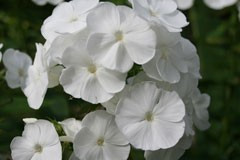- Out-of-Stock



Named after the inspiring Dutch landscape architect, a beautiful white form of Phlox paniculata. Cut all paniculata types back to the ground after flowering and they will respond with secondary growth much like oriental poppies.
Named after the inspiring Dutch landscape architect, a beautiful white form of Phlox paniculata. Cut all paniculata types back to the ground after flowering and they will respond with secondary growth much like oriental poppies.
Data sheet
A recent introduction by us is this sedum from my mothers garden, with white flowers, which is an unusual colour in the world of sedums! As with other sedums, easy to grow in full sun position in most soil types. Rarely but occasionally these can produce a pale pink sport, which should be removed with a sharp knife at the crown at the time of flowering.
The lovely and hardy winter flowering iris from Greece with lavender flowers during winter. Survives well in dry summer areas.
A lower compact form that is brilliant for massed foreground plantings at 40cm high. These cheerful flowers combine well with other summer flowering perennials like echinacea, sedums, salvias, and perennial grasses. Ideal in coastal and Mediterranean climates.
Rare white form of the usual blue, useful for ground cover in part shade or sun. Vigorous and spreading like the blue form.
Special unusual mounding variety from mountains of Turkey and Armenia, for the rock garden or border. Likes it rocky but fertile and ensure drained not acid soil and plenty of grit, very cold tolerant and tough once established. Flowers start green then age pink with onset of cold nights.
Reddish purple foliage variety; flowers in mixed colours from orange to red. A welcome addition to the summer border, providing some colourful foliage variation.
Low mounding variety that will trail over a wall or amongst rocks, likes drained drier soil types. Tasmanian native, very pretty plant and surprisingly tough, will withstand summer dry.
Our best blue variety, light sky blue with white bicolour. Plant in blocks for maximum impact and avoid heavy summer irrigation as with all lupins.
A winter flowering variety with bright flame red inflorescences. The notable feature of this species is the spherical form of the pokers, quite distinct from other varieties.
Lovely white form of the normally purple species.This campanula doesn"t like too much winter wet or shade.
A low-spreading variety with attractive grey-green leaves and pink flowers. Great under roses with Heuchera americana and Alchemilla mollis.
Totally prostrate thyme with white flowers. Good green foliage colour and perfect amongst stepping stones and cobbles. The pink equivalent is Thymus "Minimus"
Low mounding perennial for foreground colour, useful ground cover when mass planted at 25cm spacings under roses and along pathways. White form with pink eye, long flowering. Combine with dianthus helianthemum and miniature bulbs.
A beautiful variety for mediterranean themed gardens and one of our favourite matt forming perennials. The silver foliage is evergreen and creates a good low ground cover for edges and foreground plantings. Added to its attractive appearance, easy cultivation and a long flowering period makes it a great plant for Australian gardens.
Strong upright variety great for amongst grasses and floral work. Best on drained soils. Cut to the ground in winter every 2-3 years when growth congested.
Rose pink form of Viola odorata, use as ground cover in shade under trees amongst Dicentra and Hostas.

Named after the inspiring Dutch landscape architect, a beautiful white form of Phlox paniculata. Cut all paniculata types back to the ground after flowering and they will respond with secondary growth much like oriental poppies.